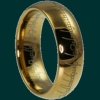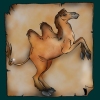Brevet är taget ur boken The Letters of J. R. R. Tolkien, som sammanställts av Humphrey Carpenter (som också bl a skrivit den officiella biografin om Tolkien) med bistånd från Christopher Tolkien. I Houghton Mifflins pocketutgåva återges detta brev, som i boken fått ordningsnummer 229, på sidorna 305-307. Fotnoten är tagen från sidan 448.
Det är för undertecknad oklart hur det förhåller sig med upphovsrätt o dyl för detta gamla brev, men om någon som vet bättre anser att det inte bör ligga ute på internet så är denne välkommen att höra av sig! Jag kan nås via diskussionsforumet på Tolkiens Arda, där jag har pseudonymen Den stegrande kamelen.
229 From a letter to Allen & Unwin 23 February 1961
I now enclose a copy and version of Ohlmarks' nonsense. In the hope that you may think it justifies my annoyance. I have not looked at his second outburst. I feel I cannot just now take any more.
[The following are excerpts from Tolkien's commentary on Åke Ohlmarks' introduction to the Swedish translation of The Lord of the Rings. Passages in italics are quotations from Tolkien's translation of the introduction.]
It is hard to believe that the deep-rooted native-born hobbit from Middle South England .... would feel very much at home [in Leeds]. Inauguration into the Anglo-Saxon chair in Oxford was for him like coming home again from a trial expedition up to the distant 'Fornost'.
This is O[hlmarks]'s first serious piece of presumptuous impertinence..... I was devoted to the University of Leeds, which was very good to me, and to the students, whom I left with regret. The present students are among my most attentive readers, and write to me (especially about the Appendices). If O's nonsense was to come to the notice of the University it would give offence, and O would have to publicly apologize. As for 'Fornost', a glance at the book would show that it is comparable rather to the Kings' mounds at Old Uppsala than to the city of Leeds!
One of his most important writings, published in 1953, also treats of another famous homecoming, 'The Homecoming of Beorhtnot, [sic] Beorhthelm's son.'
Coming home dead without a head (as Beorhtnoth did) is not very delightful. But this is spoof. O. knows nothing about Beorhtnoth, or his homecoming (never mentioned till I wrote a poem about it) and he has not seen the poem. I do not blame him, except for writing as if he knew.
The professor began by telling tales about it [Middle-earth] to his children, then to his grandchildren; and they were fascinated and clamoured for more and still more. One can clearly see before one the fireside evenings in the peaceful villa out at Sandfield Road in Headington near Oxford .... with the Barrowdowns or Headington Hills in the rear and the Misty Mountains or the 560 feet high Shotover in the background.
!!This is such outrageous nonsense that I should suspect mockery, if I did not observe that O. is ever ready to assume intimate knowledge that he has not got. I have only two grandchildren. One 18 who first heard of the book 5 years ago. The other is only 2. The book was written before I moved to Headington, which has no hills, but is on a shoulder (as it were) of Shotover.
The Ring is in a certain way 'der Nibelungen Ring' ....
Both Rings were round, and there the resemblance ceases.
....which was originally forged by Volund the master-smith, and then by way of Vittka-Andvare passed through the hands of the mighty asar [Æsir] into the possession of Hreidmar and the dragon, after the dragon's fall coming to Sigurd the dragonslayer, after his murder by treacherous conspirators coming to the Burgundians, after their death in Atle's snake-pit coming to the Huns, then to the sons of Jonaker, to the Gothic tyrant Ermanrik, etc.
Thank heaven for the etc. I began to fear that it would turn up in my pocket. Evidently Dr. O thinks that it is in his. But what is the point of all this? Those who know something about the Old Norse side of the 'Nibelung' traditions (mainly referred to since the name-forms used are Norse) will think this a farrago of nonsense; those who do not, will hardly be interested. But perhaps they are also meant to conclude that Dr. O also has mästerskap.1 It has nothing whatsoever to do with The Lord of the Rings. As for Wayland Smith being a Pan-type, or being reflected both in Bombadil and in Gollum: this is sufficient example of the silly methods and nonsensical conclusions of Dr. O. He is welcome to the rubbish, but I do not see that he, as a translator, has any right to unload it here.
Here [in Mordor] rules the personification of satanic might Sauron (read perhaps in the same partial fashion [as other identifications Ohlmarks has made] Stalin).
There is no 'perhaps' about it. I utterly repudiate any such 'reading', which angers me. The situation was conceived long before the Russian revolution. Such allegory is entirely foreign to my thought. The placing of Mordor in the east was due to simple narrative and geographical necessity, within my 'mythology'. The original stronghold of Evil was (as traditionally) in the North; but as that had been destroyed, and was indeed under the sea, there had to be a new stronghold, far removed from the Valar, the Elves, and the sea-power of Númenor.
There are reminiscences of journeys on foot in his own youth up into the Welsh border-regions.
As Bilbo said of the dwarves, he seems to know as much of my private pantries as I do myself. Or pretends to. I never walked in Wales or the marches in my youth. Why should I be made an object of fiction while still alive?
[229] 1. Swedish, 'mastery, masterly skill'.



